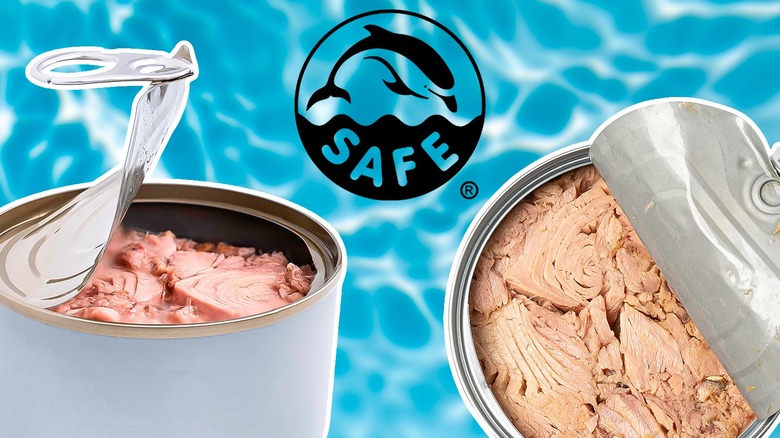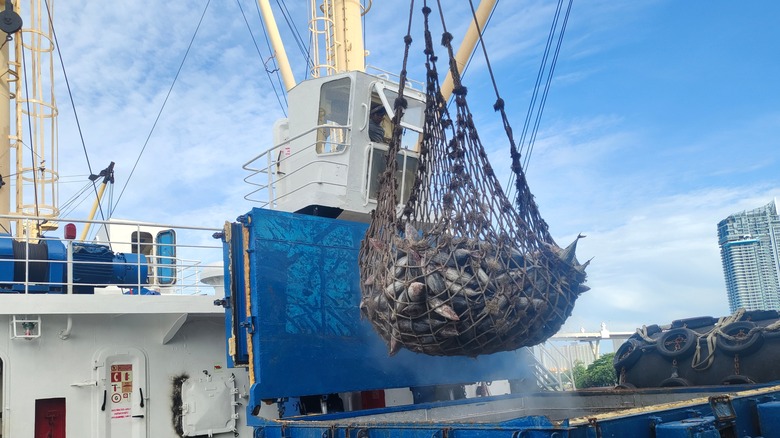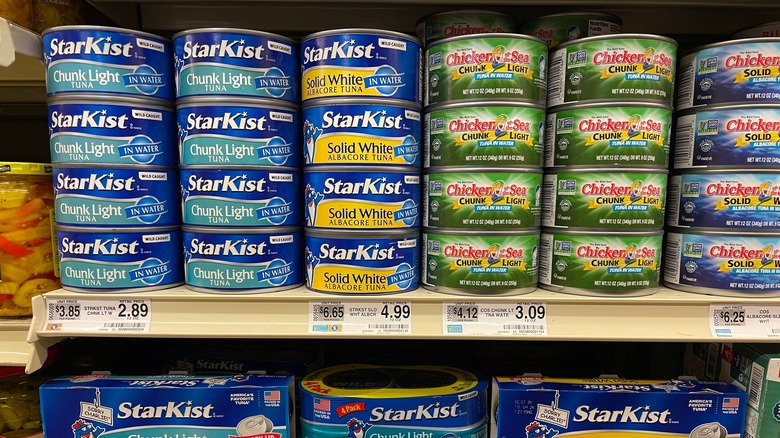What The Dolphin-Safe Label Actually Means For Canned Tuna
If you read labels on food items before you buy them, then you've probably seen the dolphin-safe label on many brands of canned tuna. This graphic isn't informing you that the product is safe for dolphins to eat, or even hinting that the can contains dolphin meat mixed in with the tuna. It's meant to let you know that no dolphins were intentionally captured or harmed when the tuna was caught.
You may be wondering what catching dolphins has to do with catching tuna. Most tuna don't swim with dolphins, but yellowfin tuna are known to congregate under multiple species of dolphins in the eastern tropical Pacific Ocean. One of the most common ways fishermen catch large amounts of fish at a time is called purse seine, in which a large vertical net encircles the fish and closes from the bottom like a drawstring purse. When fishermen attempt to catch this particular species of tuna using purse seine methods, they catch dolphins along with the real target. This kind of fishing started to become a problem as early as the 1950s when the demand for canned tuna was on the rise. Because of this practice, millions of dolphins drowned in tuna fishing nets. It would take decades before it was finally addressed.
The dolphin-safe label is backed by federal regulation
In 1990, the Dolphin Protection Consumer Information Act (DPICA) was passed to place a global ban on high seas driftnet fishing. It also protects the dolphin population in the Pacific Ocean from potential endangerment caused by purse seine fishing, circling, or chasing. Under this act, it is illegal for canned tuna brands to put the dolphin-safe label on their products if the methods of fishing are not dolphin-safe (as described by the DPICA).
On May 21, 1998, the United States became a party to the Agreement on the International Dolphin Conservation Program (AIDCP), which was enforced starting in February 1999. Countries such as Columbia, Ecuador, Honduras, and more signed the agreement to eliminate dolphin mortalities, bycatch of young tuna, and non-target species. Additionally, from this agreement, a tuna tracking program was formed. The purpose of the program is to monitor the production and importation of all tuna products to ensure they align with the dolphin-safe federal labeling regulations.
Non-dolphin-safe canned tuna is still available
Although the DPICA ensures transparency by making it illegal for noncompliant tuna producers, importers, and sellers to label their tuna as dolphin-safe, this doesn't mean that all canned tuna is dolphin-safe. It is still perfectly legal for U.S. importers and processing companies to buy and sell non-dolphin-safe tuna.
Still, product transparency and this type of labeling can help consumers decide which brand of canned tuna to buy based on their personal beliefs and allow them to hold producers to a legal standard. For example, because of these federal regulations, a class-action lawsuit was filed against the three largest U.S. tuna brands (StarKist, Chicken of the Sea, and Bumble Bee) in 2019, accusing the brands of misleading marketing using the "dolphin-safe" labels, according to CBS. Claimants argued that the brands didn't always use more dolphin-safe fishing methods used by competitors. In particular, the suit accused Starkist of using an "alternate 'Dolphin Safe' logo" while its fishing practices still kill or harm a significant number of dolphins each year. The suit was voluntarily dismissed by the plaintiffs in November 2021.
Ultimately, the difference between dolphin-safe canned tuna and non-dolphin-safe canned tuna lies in the fishing practices most consumers never get to see. The label does not suggest that one brand will be more nutritious or more dangerous to humans than the other. As far as nutrition and safety goes, you might want to do some research on how your favorite brand of tuna is processed and canned.


